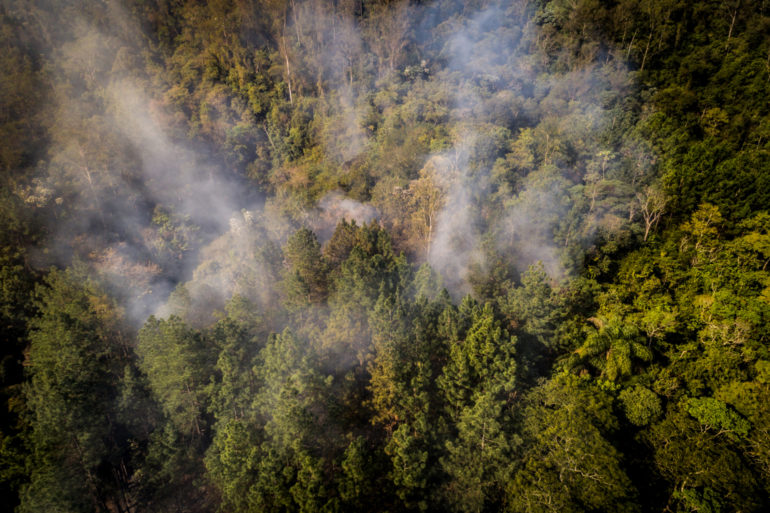The fires may not reach you, but the lasting effects will. If you believe you are far removed from the vicious fires suffocating the Amazon region, think again.
As the world’s largest rainforest — spanning eight countries — the Amazon Rainforest plays a vital role in regulating global temperatures. Yes, that means your city too!
“Forests are our greatest natural ally in the fight against global warming,” Susanne Winter, a program director at World Wildlife Fund (WWF) Germany, told EcoWatch.
With the recent uptick in wildfires, the entire planet is in grave danger. “The rainforest is not built for fire,” William Magnusson, a researcher specializing in biodiversity monitoring at the National Institute of Amazonian Research (INPA) in Manaus, Brazil, reported.
View this post on Instagram
National Geographic notes that the region is so distinctly rich in biodiversity because of the fact that it doesn’t easily burn. “A growing number of man-made fires have plagued the Amazon in recent years, imperiling the ecosystem.”
The season’s record-breaking fires — a combination of man-made fires and continued acts of deforestation — have escalated to a catastrophic level that many believe is reaching a point of no return.
How the Amazon Wildfires Affect You and Your Children
This precious ecosystem creates a domino effect; when one part is altered, it results in a chain reaction.
Air Supply
The wildfires in the Amazon Rainforest — the lungs of the planet — have the lethal power to accelerate climate change worldwide.
Rather than absorbing carbon dioxide (CO2) and releasing oxygen through photosynthesis, the fire-damaged ecosystem will reverse its system, emitting dangerous amounts of carbon dioxide into the atmosphere.
Along with elevated CO2 levels, smoke inhalation places a major threat on the body. There has been a recent spike in respiratory illnesses since the fires first broke.
Journalist Claire Bower told ABC News, “The smoke is so bad that it even caused a daytime blackout some 1,700 miles away in Sao Paulo, which is Brazil’s biggest city.”
Contributing to Climate Change
According to Greenpeace International, “as the number of fires increase, so do greenhouse gas emissions, increasing the planet’s overall temperature and the occurrence of extreme weather events, such as major droughts.”
View this post on Instagram
Dramatic changes in temperature and rainfall patterns set into motion a range of problems, including:
- extreme weather events, such as flooding
- increased insect infestation
- spread of infectious diseases
Wildlife Extinction
The rapid flames are taking a major toll on the wildlife in the Amazon. While some species are able to escape, others are being killed off right away or abandoning their offspring. Some species will soon go extinct.
“Forests depend on an intact animal world to perform functions essential to life,” Winter said.
Farming and Food Production
“The Amazon is a weather engine,” Meg Symington, the World Wildlife Fund’s senior director for the Amazon in the United States, told NBC News. Its weather patterns even affect the Midwest. As rainfall dwindles and seasons shift, a major threat is posed to farming and food production.
View this post on Instagram
Medicine
The Amazon currently produces up to 25 percent of the plants used in modern medicines, including more than 60 percent of cancer drugs.
Rainforests hold enormous potential for future discoveries because they are so rich in biodiversity. A new plant or animal species is discovered every other day. According to WWF, “with rainforests going fast, the continuity of this knowledge for the benefit of future generations is under threat.”
Household Products
From your hair-care routine to your daily diet, many of the consumer product goods we use every day include key ingredients from the rainforest.
To name a few:
- Shampoo
- Toothpaste
- Lipstick
- Detergent
- Moisturizer: many include Amazonian plants Brazil nut and coconut oil
- Latex: the main ingredient of rubber
View this post on Instagram
Food Sourced Directly from the Rainforest
- Coffee
- Chocolate
- Avocados
- Bananas
- Palm oil: found in everything from bread and ice cream, to pet food and shampoo
- Vanilla seed pods: your daily skinny vanilla latte and vanilla yogurt
- Beef: beef and leather production are both drivers of illegal deforestation in Brazil
- Soy: soy farming is another driver of deforestation in Brazil, Paraguay, and Bolivia
- Nuts: cashews and Brazil nuts
- Acai berries
And many more!
How to Help
- Reduce your carbon footprint: waste less energy, unplug your devices and turn off lights, drive less, and eat local.
- Buy products that feature the “Rainforest Alliance Certified™” seal. Find certified products here!
- Eat less meat: monitor what you eat and where it comes from. As CNN reports, many of the wildfires were caused by farmers and cattle ranchers clearing the land. Brazil ranks No. 1 for the world’s largest beef exporter. Be the change and decrease the demand for rainforest-raised beef.
- Logging is a major driver of rainforest destruction; avoid buying products made from threatened rainforest woods like Mahogany, Rosewood, and Ebony.
- Sign the World Wildlife Fund’s petition and demand that the UK government put an end to the importation of products that cause deforestation and prohibit sales in the UK.
- Contribute to the Rainforest Trust and Rainforest Alliance.
- Support the Arbor Day Foundation and help replant the rainforest.
- Support Earth Alliance (Aliança da Terra), a fire detection and prevention network. “For $2 million a year we could control the fires and stop the Amazon die-back,” said Dan Nepstad, president and founder of the Earth Innovation Institute and cofounder of Earth Alliance.
- Educate yourself and spread your knowledge.
 Emily Stone earned a degree in journalism from Elon University in North Carolina. Along with writing, Stone has a passion for digital storytelling and photography. Her work has been published in Chicago Athlete Magazine. Stone is a supporter of St. Jude Children’s Research Hospital and the National Multiple Sclerosis Society. Stone is a fluent Spanish speaker who in her free time loves a good dance class.
Emily Stone earned a degree in journalism from Elon University in North Carolina. Along with writing, Stone has a passion for digital storytelling and photography. Her work has been published in Chicago Athlete Magazine. Stone is a supporter of St. Jude Children’s Research Hospital and the National Multiple Sclerosis Society. Stone is a fluent Spanish speaker who in her free time loves a good dance class.

